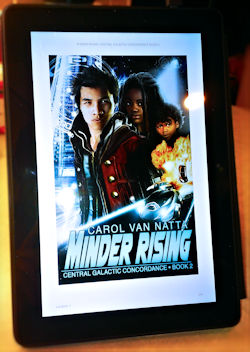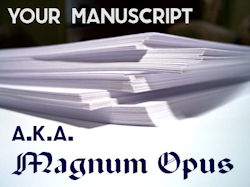How Indie Authors Get Paid
Indie Authors Get Paid? Yes, We Do

For now, I'll stick with what I know, which is how indie authors get paid for genre fiction. Caveat #1: I've only been at this for ten months, so some of my knowledge is hearsay from what other authors have said, or theoretical, because only in my dreams do I know any best-selling authors well enough to ask them money questions. Caveat #2: I publish from the U.S. If you're in another country, your mileage may vary.
Expenses for Indie Books
Let's start with what it costs to get a manuscript (a.k.a. “Magnum Opus”) published thither and yon.
First, Magnum Opus needs an editor. Yes, Magnum is a glorious masterpiece, but still needs a bit of tailoring to clean up the dangling threads and loose buttons. Depending on your confidence, skills, and whether or not you have detail-oriented beta readers, you may want a developmental or content editor, or may just need a copy editor. Costs range from a $400-$4,000, and in general, you get what you pay for (unless you've been sucked into a dubious services like those described at the very helpful Writer Beware). My editor is Shelley Holloway of Holloway House, and I highly recommend her. If you make enough changes after the editor is done, you might want to pay for a quick proofread, too, so your book doesn't get snarky reviews about typos and bad grammar.
Next, Magnum Opus needs a professional cover. I don't recommend going cheap on this, either, or your book ends up on Lousy Book Covers, Bad SF Covers, or Kindle Cover Disasters. A tolerable premade cover can be found for around $70-$80, but of course, it isn't designed specifically for Precious. Good custom covers start about $120 and go up from there.
PRO TIP: Cover design is NOT just slapping artwork and words on a page; it's a very specialized visual that has to draw the eye, communicate the genre, and be intriguing enough to make a reader read the book's blurb. Good cover designers know their stuff; unless you're an artist yourself, you should listen to them.


For the paper edition, the two most popular venues are CreateSpace (owned by Amazon.com) and Ingram Spark (owned by Ingram Publishing). If you aren't anal-retentive about how it looks, it's feasible to use one of CreateSpace's Word templates to create the book interior. IngramSpark expects a specifically-formatted PDF file. If you really want Magnum Opus to look good, hire a professional, which will cost $200-$400. A lot of indie authors are pretty good with Word, so they'll often do this step themselves to save a little money. I only have one book in paper, and that was done six years ago, so I have no current experience. BTW, it costs money (currently $49) to produce print versions with Ingram, but they can help your book sell internationally, as CreateSpace is limited to North America.
So, outside of your time—the hours you spent plotting, researching, and writing Magnum Opus—your ballpark expenses so far are:
$1,500 editing (assuming an 80,000-100,000 word manuscript)
$150 cover design
$100 file conversion (e-book)
——————
$1,750 ebook only (add another $300 for the print version)
Some authors balk at this point, because who has that kind of money lying around? It's an investment in a business. If you can't afford it, a viable option is to start looking for a publisher to work with. You get the benefit of their expertise, plus editors and cover designers they know and love, and you get marketing help. Of course the downside is, they'll take a pretty big chunk of the books purchase price for their services, and you're investing in their business, not yours. You would be correct in surmising that I'm a bit biased toward the indie publishing side of things.
Revenue for Indie Books
With files in virtual hand, you have choices as to where to upload them. You'll also need to think about price. My advice, especially if it's your first book: Don't be tempted to undervalue Magnum Opus.

You may have heard of the Kindle Unlimited (KU) program, wherein you as a reader pay a flat $10 monthly fee to borrow any book in the program. That last part is key. To be in the program, authors must sign up and agreement to sell exclusively through Amazon (not Nook, iBooks, Kobo, Google Play, etc.) for 90-day periods. Amazon pools the borrow program money and adds an unspecified additional amount into a pool, then pays authors based on the number of pages read of the book. The net profit per book is usually less than the 70% from regular sales, but being in the KU program means more books read and sold because Amazon markets them more aggressively. It's generally a better sales tool for authors who have three or more books out, especially if they're in a series.
Paper book sales for fiction can bring in a modest income, and for some authors, a lot, but for those of us with few books out and a small fan base, it doesn't make economic sense. If I'm lucky, I make $2.50/copy, meaning I have to sell around 120 of them just to break even. To do that, I need to hand sell (e.g., set up a table at a science fiction convention, convince readers they make great gift) or get them in bookstores, which is its own can of worms.
Amazon, Kobo, Nook, iTunes, and Google all pay authors every 30 days for the sales they made two months before (e.g., the payments I got at the end of July were for sales in May). For comparison, most traditional publishers only pay every 6 months (or annually, if the book isn't selling well).
So, how many copies of a book sell per month? Depending on the month, zero to tens of thousands. I know, not helpful, but true. It depends on sales and marketing, timing, events, acts of nature, luck, competition, and a dozen other factors that none of us understand. And by “none of us,” I mean not even the big traditional publishers, because the ground is shifting beneath their feet as much as it is for indie authors. But we all do get paid, eventually, because you, dear reader, buy and and read what we have on offer, and sometimes write nice reviews. For which, I thank you.










